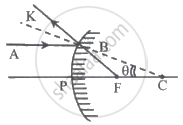Advertisements
Advertisements
प्रश्न
Answer the following question in detail.
What is the limitation in increasing the magnifying powers of a compound microscope?
उत्तर
In the case of a compound microscope,
M = `"m"_"o"xx"M"_"e"="v"_"o"/"u"_"o"xx"D"/"u"_"e"`
Thus, in order to increase mo, we need to decrease uo. Thereby, the object comes closer and closer to the focus of the objective. This increases vo and hence the length of the microscope. Therefore, mo can be increased only within the limitation of the length of the microscope.
APPEARS IN
संबंधित प्रश्न
Answer the following question in detail.
Derive an expression for the magnifying power of a simple microscope. Obtain its minimum and maximum values in terms of its focal length.
Answer the following question in detail.
What is a terrestrial telescope and an astronomical telescope?
Answer the following question in detail.
Obtain the expressions for magnifying power and the length of an astronomical telescope under normal adjustments.
Answer the following question in detail.
What is the limitation in increasing the magnifying powers of the astronomical telescope?
Discuss about simple microscope and obtain the equations for magnification for near point focusing and normal focusing.
Why is oil-immersed objective preferred in a microscope?
What are the uses of spectrometer?
What is myopia?
What is the remedy of myopia?
What is presbyopia?
Mention different parts of the spectrometer.
Explain the preliminary adjustments of the spectrometer.
A light wave of wavelength λ is incident on a slit of width d. The resulting diffraction pattern is observed on a screen at a distance D. If linear width of the principal maxima is equal to the width of the slit, then the distance D is
There are four convex lenses L1, L2, L3 and L4 of focal length 2, 4, 6 and 8 cm, respectively. Two of these lenses from a telescope of length 10 cm and magnifying power 4. The objective and eye lenses are respectively
If astronomical telescope of length 1.53 m has magnifying power of magnitude 50, the values of fo and fe are ____________.
The magnifying power of a telescope is nine. When it is adjusted for parallel rays, the distance between the objective and eyepiece is 20 cm. The focal length of objective and eyepiece are respectively.
The magnifying power of a telescope is high if its objective and eyepiece have respectively ______.
Magnification produced by astronomical telescope for normal adjustment is 10 and length of telescope is 1.1 m. The magnification when the image is formed at least distance of distinct vision (D = 25 cm) is ______.
In the adjoining figure, AB represents the incident ray, and BK is the reflected ray. If angle BCF = θ, then ∠BFP is given by ______.

A camera objective has an aperture diameter of d. If the aperture is reduced to diameter d/2, the exposure time under identical conditions of light should be made ______.
